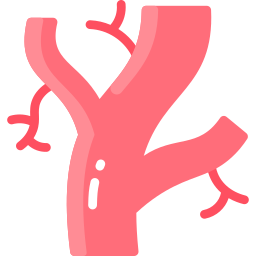![]() Cerebral Arteriovenous Malformations
Cerebral Arteriovenous Malformations
To understand what a cerebral arteriovenous malformation (AVM) is, it is first necessary to know simple concepts of anatomy. In the human body, all organs (brain, heart, liver, etc.) are irrigated/nourished by the blood, which leaves the heart and reaches these organs through the arteries.
Arteries are robust vessels, which have muscle in their walls and therefore support “working” in high pressure regimes. The blood used by these same organs is carried through the veins back to the heart. Veins, in turn, are thinner and more delicate structures that cannot withstand high pressure.
Within each organ there are the so-called capillaries, which are networks of small blood vessels that, among several functions, serve to receive arterial blood with high pressure and deliver blood with low pressure to the vein.
- AVMs are usually clinically silent until the initial symptom, which can be hemorrhage, seizures, or neurologic deficits.
- Clinically, they may manifest as headaches (headaches), seizures (epileptic seizures), or loss of strength on one side of the body. Some patients may have symptoms depending on where in the brain the AVMs are located, such as loss of vision, in AVMs close to the areas of vision, or motor deficit, in AVMs close to the motor areas of the brain.
Cerebral arteriovenous malformations are complex lesions and the type of treatment proposed will largely depend on the symptoms presented by the patient. In asymptomatic AVMs or whose symptoms are controlled with medications (headaches that improve with analgesics or seizures controlled with medications) we can adopt a conservative approach.
In AVMs that bled, treatment of the lesion is usually indicated, except in exceptional situations. There are currently 3 modes available:
- Embolization: a minimally invasive technique where the endovascular neurosurgeon/interventional neuroradiologist will access the cerebral AVM using microcatheters that will enter the arterial circulation through a puncture made in the patient’s groin (femoral artery). Once in the bloodstream, the doctor will place these small catheters inside the AVM and then inject a kind of biological glue that will fill the entire lesion, excluding it from the cerebral circulation;
- Open surgery: in this treatment modality, the vascular neurosurgeon opens the patient’s skull and, after careful separation of the AVM from the patient’s brain tissue, the entire lesion is removed en bloc;
- Radiosurgery: in this treatment modality, a beam of radiation concentrated on the arteriovenous malformation is applied. This radiation will promote, after a few years, a necrosis and consequent closure of the lesion.
As it is a complex disease, each AVM must be evaluated individually and the most appropriate treatment proposed for each patient. Embolization has been gaining more and more space as a treatment option given its constant evolution, with the emergence of new materials and new techniques. In more complex AVMs, we can combine the 3 techniques to achieve complete healing of the lesion.
How is Cerebral Arteriovenous Malformation (MAv) diagnosed?
The diagnosis of a cerebral AVM is made through several exams, such as computed tomography of the skull, magnetic resonance imaging of the brain and cerebral arteriography, the latter being the most important when one wants to evaluate the lesion in detail and define the best way to treat it.
Why do arteriovenous malformations arise?
The true origin of AVMs is not yet known, many authors still consider it a congenital disease, that is, they are formed during pregnancy and are already present at birth. However, we already have several cases published in the literature showing people who “developed” arteriovenous malformation throughout their lives.
What are the complications of an arteriovenous malformation?
Bleeding related to AVMs account for 2% of all strokes. The average annual bleeding risk of an AVM varies from 2 to 4% in the literature. Mortality is 1% per year. After the first bleeding episode, the risk of rebleeding increases to 6 to 18% in the first year.
After each AVM bleed, there is a 5 to 15% mortality rate and a 20 to 30% risk of major sequelae. However, not all AVMs have the same risk of bleeding, and some factors are related to a greater or lesser risk of rupture.
An interesting phenomenon is that, as there is a rapid passage of arterial blood to the vein, the normal brain, adjacent to the AVM, can suffer a “flow theft”, which can suffer ischemia, which can cause a neurological deficit or seizure.







